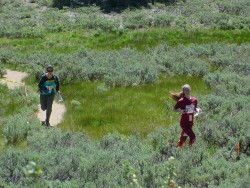What Is Orienteering?
In orienteering, you use a map and a compass to locate a series of points shown on a specialized topo map, choosing routes—on or off trail—that will help you find all the points and get to the finish in the shortest amount of time (assuming that you choose to be competitive).
Each point, or "control", is a distinctly mapped feature, such as a stream junction, boulder, or hilltop, and is marked with an orange-and-white flag, or "bag".
In order to prove that you have visited a control, you use a punch hanging from the bag to mark your control card (which is given to you when you register on the day of the event). The patterns of the punches vary, and each course will have its own unique set of punches. Alternatively, if "E-Punch" is being used, there's a small electronic box at the bag, and you insert a small "E-Stick" that you carry—the control number and time of visit are recorded in your E-Stick.
Most events offer traditional point-to-point courses, of which there are seven standard difficulties/lengths as described on this page. On a point-to-point course you must visit the controls in the prescribed order. Some events offer other course formats, such as Score-O (in which controls can be punched in any order, in a fixed amount of time) and Night-O (which can have point-to-point or Score-O format). All the various course types are described here.
Also, most events use staggered starts, to help ensure that you get to navigate on your own without interference or distraction (or assistance) from other participants. (Note that you can register and start any time during the periods specified for the event.) The route you take between controls is up to you. You select which way of traveling between controls will be the most efficient for you.
The element of route choice is what makes orienteering a mental challenge. It is not enough to simply be able to move faster than other orienteers, you must out-think them as well. Because of this, Orienteering is often called the "thinking sport" because it involves map reading and quick decision-making, in addition to athletic ability.
Please check the menu on the right for more frequently asked questions. In addition, these other Web sites provide additional detail on this international sport:
- Orienteering USA "New to Orienteering" page (http://orienteeringusa.org/new-o)
- Orienteering USA Resources page (http://orienteeringusa.org/new-o/resources)
- Glossaries of key orienteering terms: this site (http://www.us.orienteering.org/new-o/o-lingo) and this site (http://www.chicago-orienteering.org/glossary.htm)
- How to use a compass (http://www.learn-orienteering.org/old/)
- Quiz on orienteering control-description (clue-sheet) symbols (https://www.sporcle.com/games/Steerpike/orienteering-control-descriptions) – Another quiz (http://richtig-orientieren.de/icd/)
- Quiz on orienteering map symbols (https://www.octavian-droobers.org/index.php/coaching/on-line-quizzes/294-map-symbol-training) – Another quiz (http://richtig-orientieren.de/icd/mst/)
- Orienteering for the young (http://orienteeringusa.org/youth-leaders/materials/o-young)
Also, be sure to visit our Photos and Videos page for links to videos about orienteering.

